Repair Protein Mutations – Friday Pop Quiz 6/12
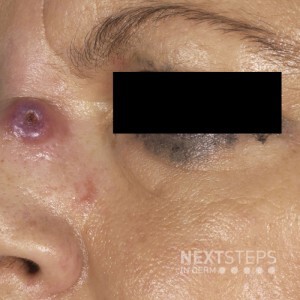 A 35 year old female is found to have mismatch repair protein mutations and this finding. Which of the following is the next best step?
A. Check BUN/Cr
B. Check TSH/T4
C. Positron emission tomography
D. Urinary cytology
E. CT Head
To find out the correct answer and read the explanation, click here.
Brought to you by our brand partner Derm In-Review. A product of SanovaWorks. …
A 35 year old female is found to have mismatch repair protein mutations and this finding. Which of the following is the next best step?
A. Check BUN/Cr
B. Check TSH/T4
C. Positron emission tomography
D. Urinary cytology
E. CT Head
To find out the correct answer and read the explanation, click here.
Brought to you by our brand partner Derm In-Review. A product of SanovaWorks. …
 A 35 year old female is found to have mismatch repair protein mutations and this finding. Which of the following is the next best step?
A. Check BUN/Cr
B. Check TSH/T4
C. Positron emission tomography
D. Urinary cytology
E. CT Head
To find out the correct answer and read the explanation, click here.
Brought to you by our brand partner Derm In-Review. A product of SanovaWorks. …
A 35 year old female is found to have mismatch repair protein mutations and this finding. Which of the following is the next best step?
A. Check BUN/Cr
B. Check TSH/T4
C. Positron emission tomography
D. Urinary cytology
E. CT Head
To find out the correct answer and read the explanation, click here.
Brought to you by our brand partner Derm In-Review. A product of SanovaWorks. … Continue reading "Repair Protein Mutations – Friday Pop Quiz 6/12"


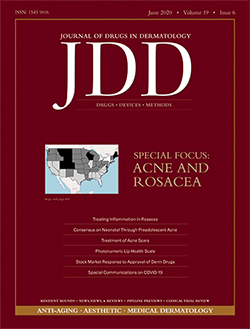 Here are the June JDD Issue Highlights:
Guest Editor Dr. James Q. Del Rosso stresses that even the best case scenario of teledermatology can never offer the same as a live in-person visit in Virtual Exams No Substitute for In-Person Care of Acne and Rosacea.
Treating Inflammation in Rosacea: Current Options and Unmet Needs, authors discuss the underlying inflammatory nature of rosacea, tre …
Here are the June JDD Issue Highlights:
Guest Editor Dr. James Q. Del Rosso stresses that even the best case scenario of teledermatology can never offer the same as a live in-person visit in Virtual Exams No Substitute for In-Person Care of Acne and Rosacea.
Treating Inflammation in Rosacea: Current Options and Unmet Needs, authors discuss the underlying inflammatory nature of rosacea, tre … 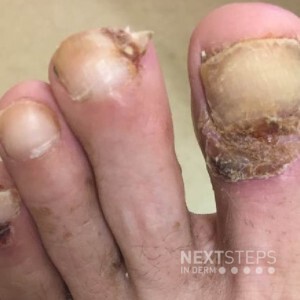 The patient developed this cutaneous adverse event 2 weeks after starting a clinical trial medication. What is the mechanism of action of the culprit medication?
A. Epidermal growth factor receptor (EGFR) inhibitor
B. Tumor necrosis factor (TNF)-alpha inhibitor
C. Smoothened inhibitor
D. BRAF inhibitor
E. Programmed cell death (PD)-1 inhibitor
To find out the correct answer and …
The patient developed this cutaneous adverse event 2 weeks after starting a clinical trial medication. What is the mechanism of action of the culprit medication?
A. Epidermal growth factor receptor (EGFR) inhibitor
B. Tumor necrosis factor (TNF)-alpha inhibitor
C. Smoothened inhibitor
D. BRAF inhibitor
E. Programmed cell death (PD)-1 inhibitor
To find out the correct answer and … 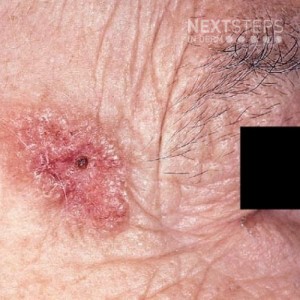 This patient presents for Mohs surgery. What is the deepest layer that you can undermine in this area?
A. Epidermis
B. Dermis
C. Subcutaneous fat
D. Superficial muscular aponeurotic system (SMAS)
E. Muscle
To find out the correct answer and read the explanation, click here.
Brought to you by our brand partner Derm In-Review. A product of SanovaWorks.
…
This patient presents for Mohs surgery. What is the deepest layer that you can undermine in this area?
A. Epidermis
B. Dermis
C. Subcutaneous fat
D. Superficial muscular aponeurotic system (SMAS)
E. Muscle
To find out the correct answer and read the explanation, click here.
Brought to you by our brand partner Derm In-Review. A product of SanovaWorks.
… 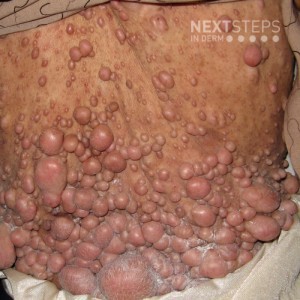 What is the most common cause of hypertension in this patient?
A. Autonomic Dysregulation
B. Optic Glioma
C. Renal Artery Stenosis
D. Medication induced
E. Medullary adrenal gland tumor
To find out the correct answer and read the explanation, click here.
Brought to you by our brand partner Derm In-Review. A product of SanovaWorks.
…
What is the most common cause of hypertension in this patient?
A. Autonomic Dysregulation
B. Optic Glioma
C. Renal Artery Stenosis
D. Medication induced
E. Medullary adrenal gland tumor
To find out the correct answer and read the explanation, click here.
Brought to you by our brand partner Derm In-Review. A product of SanovaWorks.
…